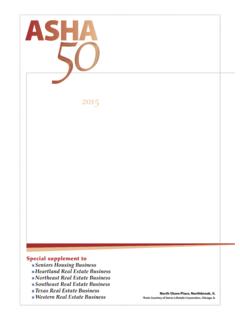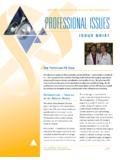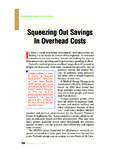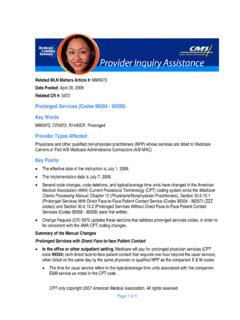Transcription of Standardization of prior authorization process for …
1 Visit for more information on the AMA s administrative simplification recommendations. Copyright 2011 american medical association . All rights reserved. Standardization of prior authorization process for medical services white paper Prepared by the american medical association Private Sector Advocacy June 2011 The american medical association (AMA) strongly supports the provisions in the Patient Protection and Affordable Care Act (ACA) that are designed to streamline the claims management revenue cycle. The AMA is committed to eliminating administrative waste in the health care delivery system. Cost estimates of inefficient health care claims processing, payment and reconciliation are between $21 and $210 billion. In the physician practice, the claims management revenue cycle consumes an unsustainable 10 14 percent of practice revenue. The current system is all too often manual.
2 It must be replaced by automated, transparent, unambiguous, real-time health care transactions. This white paper focuses on the streamlining, Standardization and automation of the process for the prior authorization of medical services and does not address or debate the need for prior authorization of medical services. 1 The prior authorization process for pharmaceuticals will be discussed in a companion white paper expected in the third quarter of 2011. To automate the prior authorization process and reduce costs, the system needs to: Standardize the process across payers and apply it consistently Ensure that, as much as possible, the prior authorization process can be programmed into the payer administrative and physician practice systems and their respective work flows Ensure that all payers support the Health Insurance Portability and Accountability Act (HIPAA) Accredited Standards Committee (ASC) X12N 278 Health Care Services Review Request for Review and Response standard transaction We believe these goals can be accomplished while still allowing payers to maintain their own benefit designs and payment levels.
3 While the AMA believes that prior authorization programs are often overly inclusive and would welcome the opportunity to work with the payer community to find alternatives to these programs when feasible, this paper focuses solely on the prior authorization process . It assumes that prior authorization programs will be used but looks to ways to minimize the associated administrative burden these programs place on payers and physicians alike. Introduction Because of their expertise and relationship with their patients, physicians are best suited to educate patients on costs, treatment options and other alternatives. Providing the patient with information on costs, benefits and treatment options for identified services should be an efficient and quick process that is integrated within the clinical work flow of the practice. To enable physicians to conduct this education at the point of care, however, payers need to provide the tools, 1 prior authorization includes any process that requires obtaining approval for performance of a procedure or service from a health insurer.
4 prior authorization is also commonly referred to as precertification, prior notification, prior approval, prospective review, prior review, certification or precertification. Page 2 Copyright 2011 american medical association . All rights reserved. data, rules and other information historically reserved for their own internal usage to physicians in a fashion that allows the information to be integrated into the continuum of providing care to the patient. Physicians are presumed to be able to combine this information with their personal knowledge of the patient s health and personal issues to arrive at the best recommendation. This reengineering exercise should extend to the prior authorization process . The current intensely manual process can be improved substantially by making all relevant information available to physicians at the point of care. This would improve the patients experience while reducing the costs associated with the prior authorization process for both payers and physicians.
5 To accomplish real-time prior authorization at the point of care, trust will need to be rebuilt between payers and physicians. Both will need to agree to engage in a partnership approach in which it is recognized that the payers know the benefit limits of a particular patient and may also have databases of best practices and other clinical decision support tools of value to physicians and their practice staff. Physicians, in turn, know best the patient and the specifics of the particular situation, are in the ideal position to provide a timely response if given the appropriate resources, and are in the best position to provide alternatives to patients when costs and benefit limits are real considerations. Indeed, as individual physicians demonstrate their ability to arrive at agreed decision/information points based on best practices, it may make sense to consider eliminating prior authorization requirements entirely.
6 In any event, the stronger the foundation of partnership and trust, the more efficient the process may become. prior authorization : Current status described The current prior authorization process is extremely burdensome. According to a recent study, in 2006 the average physician practice devoted 1 hour of physician time, hours of nursing time and hours of clerical time to the prior authorization process each week in The administrative burdens experienced by physicians with current practice prior authorization work flows are demonstrated by the following examples: Example one: The physician practice places a call to the payer to confirm whether prior authorization is necessary. If the answer is yes, the patient s information is then given to a payer representative who enters the information in the payer s computer system. The practice is then transferred to a nurse case manager who verifies the information.
7 The case manager then asks the practice to fax or mail all of the information. The length of time for this process is approximately 50 minutes (20 minutes to reach a payer representative, then up to 30 minutes speaking with a representative and the case manager). Example two: The physician practice calls the payer to confirm whether prior authorization is necessary. If the procedure or service requires prior authorization , the physician practice is instructed to submit a form. While some payers have their own proprietary forms, some do not, in which case the physician practice submits its own form. For those payers that have a form, the physician practice is often directed to a website that can have many forms to choose from, which requires practice staff to determine which is the appropriate one. In addition to a form, most payers also request a letter of medical necessity, which may require a history of alternatives that have been tried with no success.
8 This very manual process can take from two to four weeks to obtain a response. The following diagram (Exhibit 1) shows today s prior authorization process , which can take an extended period of time. 2 What Does It Cost Physician Practices To Interact With Health Insurance Plans, Lawrence P. Casalino et al, Health Affairs (2009): w533 w543 at w537. Page 3 Copyright 2011 american medical association . All rights reserved. Exhibit 1: Current prior authorization processes While this effort is extremely burdensome to the physician practice, the payer also expends significant time and resources handling prior authorization requests. A standardized, transparent, automated work flow would benefit all the trading partners: payers, physicians and their patients. The AMA s Report of the Council of medical Service (CMS Report 4-I-10) The AMA s CMS Report 4-I-10, which can be found in Appendix A, confirms the challenges conveyed in the above physician work flows that were raised at the 2010 AMA Annual Meeting of the House of Delegates.
9 The concerns expressed at that meeting highlighted the current plethora of payer-specific prior authorization forms, which creates burdensome hurdles for physicians and adverse health consequences for patients. The lack of Standardization makes the prior authorization process difficult and time-consuming. Moreover, the forms often lack clarity and do not contain all of the information required by payers to make a determination regarding the authorization request, potentially necessitating additional time-consuming communication for the physician practice with no additional reimbursement. The prior authorization process can also appear to be a delay tactic used by payers for financial gain and to discourage physicians from advocating for necessary services. The following Policy was established by the adoption of CMS Report 4-I-10: Our AMA: (1) supports the simplification and Standardization of the preauthorization process for physicians and patients; (2) supports the adoption of a standardized paper preauthorization form by health plans for those Page 4 Copyright 2011 american medical association .
10 All rights reserved. physicians who choose to submit paper preauthorization forms; (3) will publicize and support the legislatively mandated adoption of HIPAA electronic standard transactions by health plans and encourage adoption of HIPAA electronic standard transactions by physicians; and (4) supports efforts to develop clear and complete requirements for each HIPAA electronic standard transaction. In addition to such hurdles for physicians, the prior authorization process can have detrimental health consequences for patients. Some payers are requiring prior authorization for an increasing number of routine tests and procedures, resulting in more physician-patient interactions that require payer input and subsequent treatment delays. Lengthy prior authorization processes can interfere with patient follow-through if patients fail to return for needed medication or treatment. In addition, patients can be subjected to redundant tests due to some prior authorization requirements.





